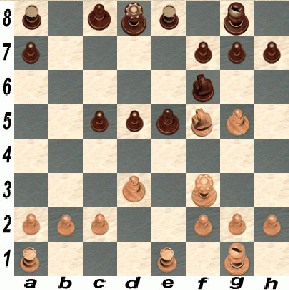1. e4,e5;
2. Nf3,Nc6;
3. d4,exd4;
4. Nxd4,Nf6;
5. Nxc6,bxc6;
6. Nc3,Bb4;
7. Bd3,d5;
8. exd5,cxd5;
9. 0-0,0-0;
10. Bg5,Bd6!?;
11. Qf3,
I did not spend much time looking at the wild complications that might
have arisen in the following variation: 11.Nxd5,Bxh2+; 12.Kh1,Qxd5; for example
(Fritz 5 analysis):
13.Bxf6,Be6! (13...,c6; 14.Bxg7,Kxg7; 15.Kxh2 gives an edge for white);
14.c4!,Qd6; 15.Bxh7+,Kh8; 16.Qh5,Bg4; 17.Bxg7+,Kxg7; 18.Qxg4,Kxh7;
19.Qh5+,Kg7; 20.Qg5+,Kh8 and the position is a draw. My opponent
is a renowned tactician and I didn't like to complicate so early. Nevertheless,
I think that in the main variation, after 15.Be4! (instead of the check in h7),
white gets a good game: both 15....,Bxc4; 16.Qh5,g6; 17.Qxh2,Qxf6; 18.Rfc1! and
15....,Qf4; 16.Bxa8,Bxc4; 17.Re1,Qxf6; 18.Kxh2 lose the exchange for little
compensation, so the best line may well be 15....,Rae8; 16.Qh5,h6; 17.c5!,Qf4;
18.Bxg7, Kxg7; 19.Bc6, with a complicated
middlegame which should favor white. By the way, I believe this is the reason
why the 10th move of black is normally played after the c6 push has been
made, i.e. 10....,c6; 11.Qf3,Bd6. My opponent got away with it this time.
11. ...,c6;
12. Ne2,
John Nunn here preferred 12.Rae1 in a game against P.Thipsay. The game went
on 12....,h6; 13.Bf4,Rb8; 14.Bxd6,Qxd6; 15.b3,c5; 16.Nb5,Qd7; 17.Nc3,Qd6;
18.h3,Be6; 19.Rd1,Qc7; 20.Rfe1,d4. Nunn won the game eventually, but his
treatment of the opening is not very illuminating.
13. Nd4,c5;
14. Nf5!?,
This is all very consistent with the plan of a quick attack on the kingside
that I had figured out when I decided for 12.Ne2,
but probably the best move would have been the surprising 14.Bxf6!, with
the following variation: 14....,Qxf6;
15.Qxd5!,Qe5; 16.Qxe5,Bxe5; 17.Bb5!,Rf8; 18.Nc6, where the initiative
overweighs the bishop pair, for example
18....,Bxb2; 19.Ne7+,Kh8; 20.Rab1,Be5; 21.Bc4 and white has a promising
position.
14. ...,Be5!;
Clearly the strongest. Black must avoid the weakening of black squares that
would result in a tradeoff with the white knight, and anyways I was already
threatening to wreck black's castling with 15.Nh6+,gxh6 (15....,Kh8 loses
instantly and 15....,Kf8 gives away at least a pawn); 16.Bxf6 with a winning
attack.
15. Rfe1!, draw.

A short game, but both of us had already spent more than
one hour and a half on it, and time was starting to become an issue.
The position looks very promising for white but black has sufficient
means for obtaining counterplay. Now each of the following possibilities
has to be carefully considered:
(A) 15....,Kh8?; 16.Nh6!! (the move white was fantasizing since his 12th!),gxh6;
17.Bxf6,Qxf6; 18.Qxf6,Bxf6; 19.Rxe8+ and white wins.
(B) 15...,Kf8?; 16.Bxf6,Qxf6; 17.Qxd5!,Bxf5; 18.Qxc5+,Kg8;
19.Bxf5,Qxf5; 20.f4,Rac8; 21.Rxe5! with a winning position for white: for
example 21....,Rxe5; 22.Qxe5,Qxe5; 23.fxe5,Rxc2; 24.Rd1,Kf8; 25.Rd8+,Ke7;
26.Ra8,Rxb2; 27.Rxa7,Ke6; 28.a4,Ra2; 29.a5,g6; 30.a6,Kxe5; 31.Rxf7,Rxa6;
32.Rxh7,Ra2; 33.Rf7 and white wins.
(C) 15....,c4; 16.Bxc4!,Bxf5; 17.Qxf5,Qd6! (17....,Bxh2+?; 18.Kxh2,Qc7+;
19.f4!,Qxc4; 20.Bxf6,gxf6; 21.Qxf6,Qxc2; 22.Rxe8+,Rxe8; 23.Rf3,Qe4;
24.Rg3+,Kf8; 25.Rg5,Re6; 26.Qd8+,Re8; 27.Qd6+,Re7; 28.Rxd5,Qe6; 29.f5,Qxd6+;
30.Rxd6, with a clear advantage for white); 18.Bd3,g6; 19.Qh3,
with unclear play.
(D) 15....,Bxf5; 16.Qxf5,g6; 17.Qf3,Kg7; 18.c4,dxc4; 19.Bxc4,Qc7; 20.Re2,
with unclear play.
(E) 15....,Bxb2; 16.Bxf6,Bxf6; 17.Rxe8+,Qxe8; 18.Nd6,Qc6; 19.Bxh7+,Kxh7;
20.Qh5+,Kg8; 21.Qxf7+,Kh8; 22.Qh5+, draw.
(F) 15. ...,Rb8!; 16.Rxe5 (16.b3,Rb6; 17.Kh1,Ba6; 18.Qh3, Bxd3; 19.cxd3,Ree6;
20.f4,Bc3; 21.Rxe6,Rxe6; 22.Qg3 is drawish),Rxe5; 17.Qg3,Rxf5
(17....,Bxf5; 18.Qxe5,Bxd3; 19.cxd3,Rb6; 20.Rc1 gives a small edge to white);
18.Bxf5,Rb6; 19.Bxc8,Qxc8; 20.Bxf6,Rxf6; 21.Rd1,d4; 22.c3,
with an equal game.
Go back to TD's Chess Page